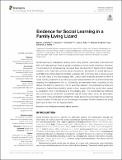Files in this item
Evidence for social learning in a family living lizard
Item metadata
| dc.contributor.author | Whiting, Martin J. | |
| dc.contributor.author | Xu, Feng | |
| dc.contributor.author | Kar, Fonti | |
| dc.contributor.author | Riley, Julia L. | |
| dc.contributor.author | Byrne, Richard W. | |
| dc.contributor.author | Noble, Daniel W. A. | |
| dc.date.accessioned | 2018-05-29T12:30:05Z | |
| dc.date.available | 2018-05-29T12:30:05Z | |
| dc.date.issued | 2018-05-29 | |
| dc.identifier | 253210477 | |
| dc.identifier | 75fd0275-406b-4606-9d53-cb5730ab12d1 | |
| dc.identifier | 000451666100001 | |
| dc.identifier | 85062818593 | |
| dc.identifier.citation | Whiting , M J , Xu , F , Kar , F , Riley , J L , Byrne , R W & Noble , D W A 2018 , ' Evidence for social learning in a family living lizard ' , Frontiers in Ecology and Evolution , vol. 6 , 70 . https://doi.org/10.3389/fevo.2018.00070 | en |
| dc.identifier.issn | 2296-701X | |
| dc.identifier.other | RIS: urn:52A304B4B11956A6960ECFB8BDCC54DB | |
| dc.identifier.other | ORCID: /0000-0001-9862-9373/work/60630533 | |
| dc.identifier.uri | https://hdl.handle.net/10023/13588 | |
| dc.description | This work was funded by the Australian Research Council (DP130102998 to MW and RB). DWAN was supported by an ARC DECRA (DE150101774) and UNSW VC Fellowship. JR was supported by the Natural Sciences and Engineering Research Council of Canada, and Macquarie University. | en |
| dc.description.abstract | Social learning is widespread among family living species, particularly mammals and birds with relatively high levels of social complexity and overt social interaction. However, the occurrence of social learning has never been documented in lizards with kin-based sociality, which have less obvious social interactions. We tested for social learning in Australian tree skinks (Egernia striolata), a species that commonly lives in family groups in the wild, using a two-step foraging task. Lizards were randomly allocated to either a social learning treatment or a control group and presented first with an instrumental task requiring the displacement of a lid, followed by an association task, consisting of two dishes with different colored lids. Prior to each task, lizards in the social learning treatment observed a trained demonstrator extract a food reward while the control also viewed a conspecific, but in the absence of the foraging task. The social learning treatment and control group solved the instrumental task at similar rates, but in the association task lizards in the social learning treatment made fewer errors and reached our learning criterion sooner. To the best of our knowledge, we present the first evidence for social learning in a lizard with kin-based sociality. | |
| dc.format.extent | 8 | |
| dc.format.extent | 536276 | |
| dc.language.iso | eng | |
| dc.relation.ispartof | Frontiers in Ecology and Evolution | en |
| dc.subject | Social learning | en |
| dc.subject | Lizard | en |
| dc.subject | Sociality | en |
| dc.subject | Egernia | en |
| dc.subject | Cognition | en |
| dc.subject | BF Psychology | en |
| dc.subject | QH301 Biology | en |
| dc.subject | DAS | en |
| dc.subject.lcc | BF | en |
| dc.subject.lcc | QH301 | en |
| dc.title | Evidence for social learning in a family living lizard | en |
| dc.type | Journal article | en |
| dc.contributor.institution | University of St Andrews. School of Psychology and Neuroscience | en |
| dc.identifier.doi | https://doi.org/10.3389/fevo.2018.00070 | |
| dc.description.status | Peer reviewed | en |
This item appears in the following Collection(s)
Items in the St Andrews Research Repository are protected by copyright, with all rights reserved, unless otherwise indicated.

